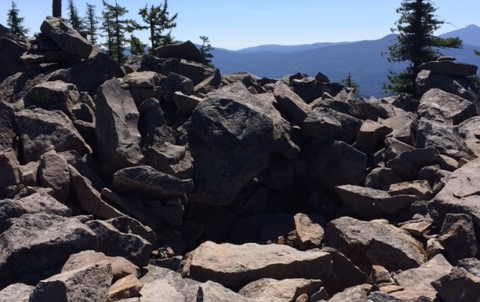Tarzan Springs, the Old Prospector, and the Glen Thomas Site
In chapter thirteen of my book Bigfoot in Evolutionary Perspective, I examined the multiple, extended sightings of a heretofore unacknowledged hoaxer in the field of bigfoot research, Glen Thomas, and the undue influence he has had on the field. At the time of writing the book, I did not have a chance to visit the site of his most well-known encounter, which in the minds of some, ranks with other classic bigfoot encounters like those of Albert Ostman or William Roe. In the purported encounter, Thomas witnessed a loosely structured family unit of three sasquatches that centered primarily upon a big male overturning and sniffing large rocks, often stacking them, then digging furiously about five feet down to retrieve and eat hibernating rodents. Perhaps because of the status given to this encounter by other researchers or perhaps because the traits/actions Thomas describes fit with a more apelike expectation of what a bigfoot might be, the contention that Thomas hoaxed his accounts has been controversial.
I have since been able to examine and analyze the Glen Thomas Site firsthand. It is located near Tarzan Springs, Oregon. The locale is named after an old prospector type who lived alone, though perhaps not completely alone as he was said to live among some “apes” according to surveyors who traveled through the area in 1922-23 and left behind a record book of the survey that documented this bit of information (Beelart and Olson, 2015).[1] Googling driving directions to Tarzan Springs, Oregon won’t likely bring up any such locale. The old-timer has long since passed and it takes much more than one isolated soul and a lot more infrastructure to officially incorporate a town, so it was more a spot known to the surveyors who named it and a few locals, and I use the term locals rather loosely as most lived miles away. I did not have much more than a crude map myself with one real landmark when trying to trace my way to the Glen Thomas Site. There were no signs indicating Tarzan Springs and I think I was only able to discern after the fact approximately where this old-timer may have lived by a bend in the road where perhaps a tiny spring—that I neither heard or officially caught sight of—may have etched out a crevice in the wild terrain. The one lane forest road, much of it paved, a luxury in itself, is not made for stopping and unnecessary sightseeing in other than a few places. You always have to be conscious of a vehicle coming the other way, and depending upon just where the two vehicles may meet, might involve considerable backing up by one or the other until there is enough wiggle room to pass without scraping off a side mirror.
Tarzan Springs wasn’t the precise goal however. It just would have been nice to have known when I passed it since the Glen Thomas Site was a little farther down the road. But after locating a landmark marked “Seasonal Pool” on the map, and driving past this approximate hiking point to verify the existence of a high rock quarry before turning back around, I was fairly certain I was in the right area. Above the seasonal pool was a talus slope with large boulders that ran nearly to the top of the ridge. It had the look of balancing on itself in a crude stasis that might crash down into a whole new configuration if the wrong rock was nudged this way or that. Perhaps playing with my mind a bit, not every rock was stable and I had a couple spin under my hiking boots as I made my way up. I was glad I wasn’t out with my usual heavy backpack. Beyond the talus slope, which took an effort to climb, it was noisy going. Underbrush. Needles. Branches blocking the way. Fallen logs. Other decaying debris. The scattered boulder or two. It was steep in places and it wasn’t straight-line walking, though it leveled out at the top. It was immediately clear I wasn’t going to be sneaking up on any wildlife. I recalled the detail in Thomas’ encounter story of ice falling noisily off the trees. It would have to be practically raining chunks of ice to cover the sound of my boots breaking through this mire. Experiencing the terrain firsthand only reinforced why it was necessary for him to manufacture this detail so that his ability to catch sight of three unaware sasquatches at close range wouldn’t be questioned.
I found two more talus slopes as I made my way along the mountain ridge, one when I purposefully diverted to the other side of the mountain to get a better sense of the geography and view. Neither of these contained disturbed rocks or boulders, excavated pits, or stacked rocks. While they couldn’t be the Thomas site, nonetheless this seemed another discrepancy. According to the Thomas account, the bigfoot had been quite successful in procuring a meal by overturning, smelling, stacking, digging, and otherwise manipulating rocks. Why then, wouldn’t this behavior be repeated on nearby talus slopes? Certainly it couldn’t have been for lack of hibernating ground squirrels if these had been extracted by the bigfoot as described?
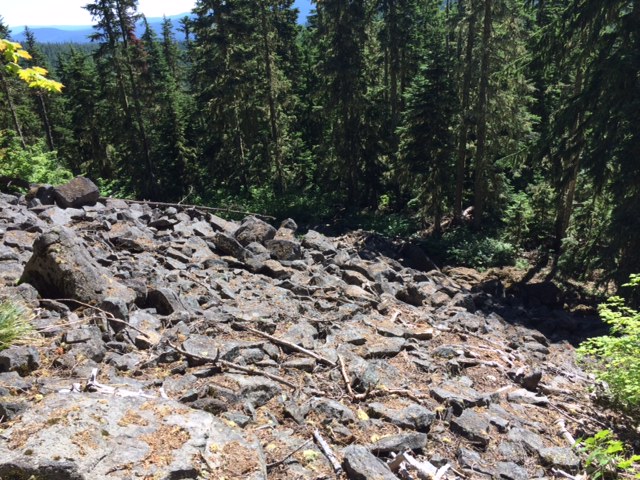
I traipsed around the ridge long enough to question whether I might even find the Thomas Site. In off-trail terrain there is sometimes a sense of being bogged down, moving in a kind of slow motion as you calculate the best spot to place your next step and a few more after that. Plus you have to look over your shoulder every so often to take account of notable trees, boulders, or other features of the terrain in case you have to retrace your exact way out. I’d elected to climb straight up the mountain rather than trying to tackle an unmaintained trail several miles long from another starting point, and perhaps that might have been the better option. But hiking alone along an unmaintained trail through country like this can come with its own set of problems. Unmaintained can be a euphemism for no real trail at all. I had to be looking for another opening, a rock site, without trees, with a view of snow-capped 10,500 foot Mt. Jefferson in the background and how hard could that be to find? An open field of bunch grass and flowers seemed promising and even here I noted how noisy my hiking boots were and how unlikely I was to sneak up on any wildlife. I moved south, wanting to catch sight of the road or quarry or the initial large talus slope I’d climbed or Mt. Jefferson to get a better sense of my bearings. Then, moving farther in this direction, beyond the bunch grass I saw the jagged rocks and the stacked rocks that indicated the Thomas bigfoot site.
I’d already known it wasn’t uncommon for other bigfoot researchers to visit the site, elevated as it was as a near-sacred pilgrimage. But I was looking at it with a skeptical eye. Multiple bigfoot encounters were the mark of a hoaxer in my analysis and Thomas had four, three of extended duration, all in less than two years, plus an extensive track find in which he reported witnessing bigfoot movements over several days. And it was just too convenient that Glen Thomas, who John Green once described as an “almost full time sasquatch hunter,”[2] never produced a single photograph, film, or track cast though he had ample opportunity. If these encounters had happened to Roger Patterson, three more films would have been added to the vault.
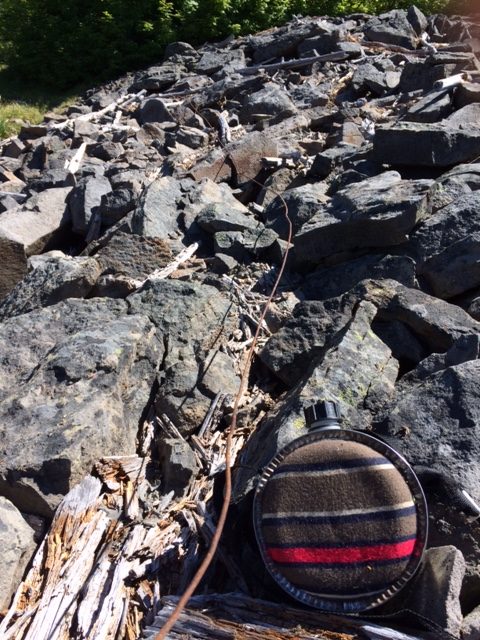
In addition to bigfoot researchers, with the road below, the site was not so remote that it couldn’t be visited by others. A long rusted strand of fencing-like wire discarded on the ground and running along the width of the western end of the rock pile confirmed such visits. Someone had made the effort to haul it here, though whether it was before or after the existence of the road I couldn’t say. What its initial purpose was I couldn’t say either.[3] The years prior had brought loggers, the previously mentioned surveyors, fire lookouts and personnel, road builders, quarry crews, and it would not have surprised me if the old prospector had stood on the talus as well, solitary and alone, or so it seemed, contemplating Mt. Jefferson in the distance. And though the visits may not have qualified as frequent, I knew hikers and even bicyclists made the trek to the site these days, so to see rock cairns that Glen Thomas attributed to the large male bigfoot stacking rocks, apparently as a way to sort the rocks it had already sniffed and found lacking in rodent odor, neither impressed me nor made much sense when it came right down to it…a lot of precise, time consuming, back and forth work for little real benefit. It would have been far more efficient to simply overturn rocks as the bigfoot moved over the rock pile. But at least it explained the rock cairns, which required some explanation—in fact, demanded it otherwise the obvious choice was they were man-made artifacts. That wasn’t to say that these rock cairns were the same ones that existed in 1967 when Thomas made his bigfoot sighting claim. I’m sure these cairns had more than evolved through the years, some tumbling, new ones being rebuilt, but always at the hands of men. Not all the rocks impressed me as being overly heavy. Some at the top of the cairns were not that large. The most surprising aspect of the site was how level much of it was at the top. It was not at all difficult to walk around, especially with measured foot placement, and move rocks if one was so inclined.
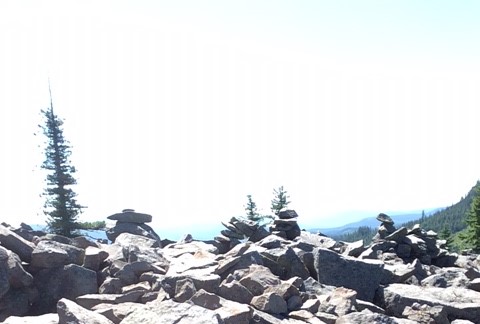
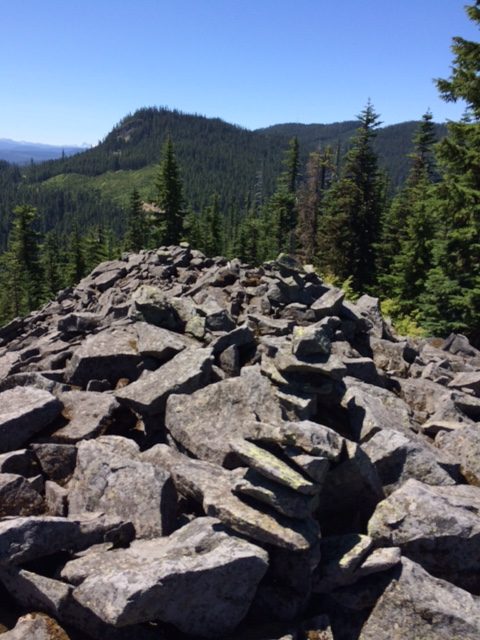
The approximate five foot deep, well-like hole that Thomas stated he had witnessed the bigfoot dig was still clearly visible, though it had degraded, collapsed to some extent, especially on the south and west sides. This could have been due to natural weathering, though it could just as easily have happened at the hands of men, rocks being knocked loose when someone jumped inside or when touched upon closer examination or for no other reason that because the rocks could be dislodged, they had been. The huge boulder that almost seems to stand on end on the eastern wall was still resting intact. I’d done some prior research before visiting the site, and I had a fairly good idea what this pit was and who had made it…and it had nothing to do with bigfoot. Native Americans, often as a rite of passage, made such pits for vision quests. A young brave might stay in the pit for two days or more, steadfastly engaged in prayer, without food or water or clothes on his back, in order to receive a vision that put him on a life course that could benefit him and the tribe.[4] Within the borders of the pit, he was untouchable from the elements, even lightning or fierce storms, or evil spirits that might manifest. Needless to say, I did not jump into the pit because it would have been culturally insensitive for me to do so.
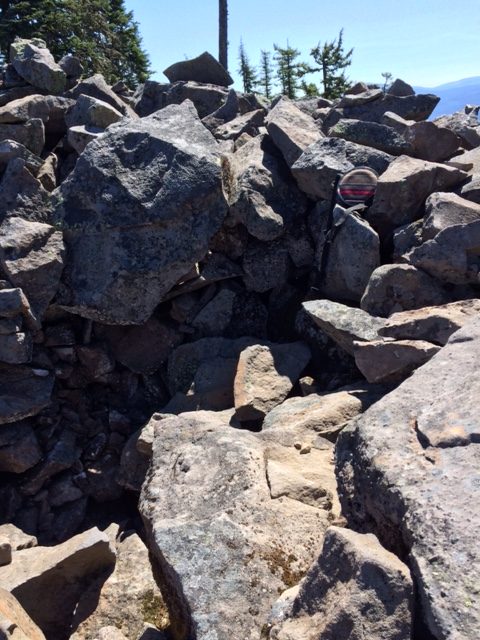
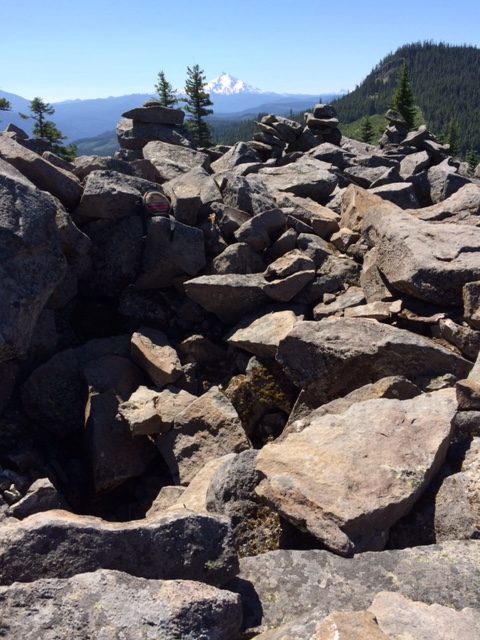
As further proof of this, there was another pit dug out of the talus rock below this one. While some might not find it as impressive as the deeper one that Thomas claimed the bigfoot made, I certainly did because one of the large boulders has a rectangular notch etched out of it, an approximate inch deep. Perhaps I caught a bit of a break that I needed to thank the Indian spirits for, because, fortuitously, lying on top of the boulder was a rock flake, approximately a quarter inch thick, rectangular in shape, that when placed in the notch of the boulder pointed due east and acted like a sun dial in accord with the rising and setting sun. I confirmed the due east reading with my compass. For some tribes, sunrise was the mark of the first moment the vision quest started. That was truly the end of the mystery of these rock pits for me. These were likely Native American vision quest pits or at least Native American relict structures of some kind.[5],[6] When I walked back to the larger pit, the huge boulder that almost seems to stand on end on the eastern wall, and which can be seen in photos in older books dedicated to the bigfoot topic, has a tip on it that also points due east, in accord with the rising sun. There is also a larger rock atop this pit and the tip of it also points due east, though I have no idea whether this rock is a recently moved artifact or may have managed to stay in place over the centuries.
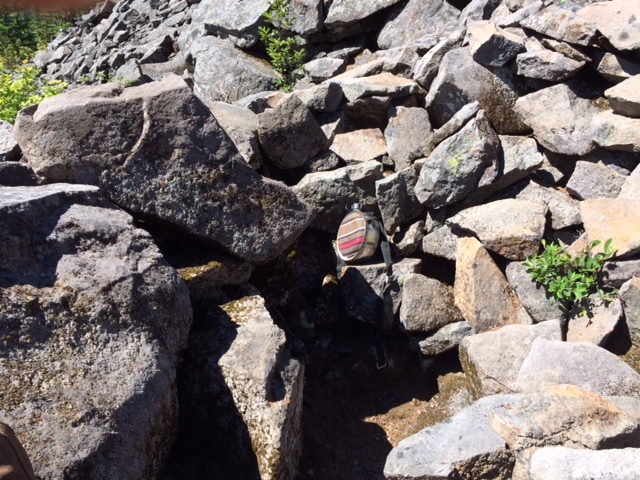
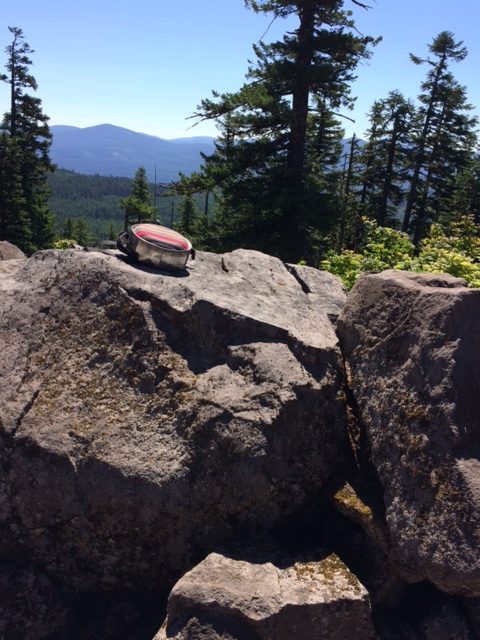
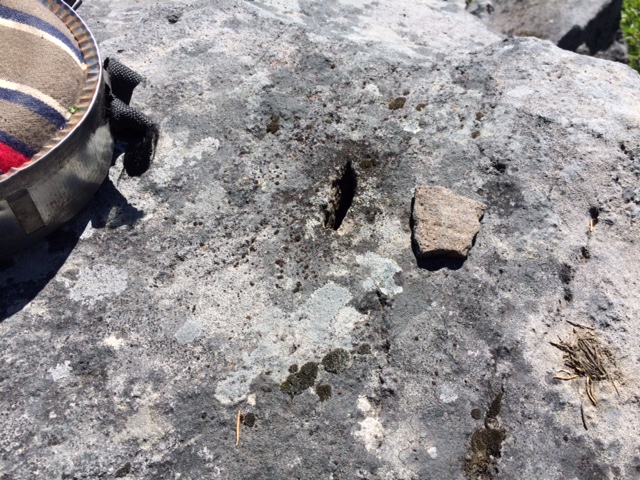
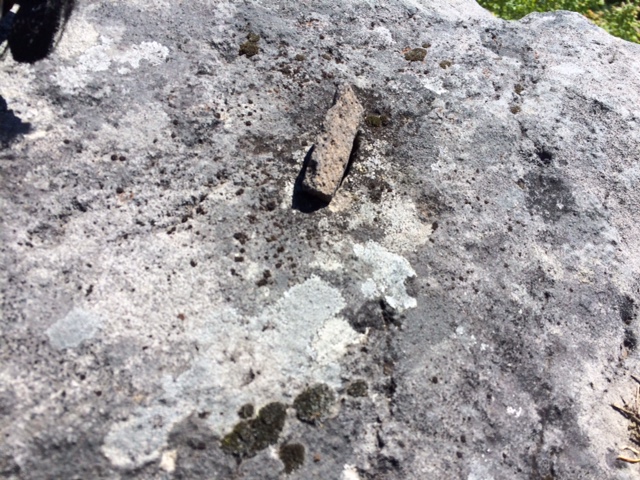
It is extremely unlikely, if not downright impossible, that the larger boulders in either of these pits were moved by Native Americans. They are far too colossal. These boulders have come to rest here by the forces of nature and I’m certain most other larger rocks in their immediate vicinity have come to rest here naturally as well. The rock site itself is a natural phenomenon and depressions behind the boulders were also likely here initially, though they were further modified and dug out by Native Americans to suit religious, ceremonial, or spiritual needs. Researchers like Whitley, Dorn, Simon, Rechtman, & Whitley (1999) point out that cairns and the vision quest are often interconnected.[7] Whether the rock cairns here are a more recent phenomenon or have been in existence for centuries I can’t say, but either way they were created by men I’m convinced, different tribes and races perhaps, but men nonetheless. It is important to note that where there are deep holes there must be cairns if it is bigfoot related according to Thomas because this is what he witnessed. This was the unique method the bigfoot employed in its search for the hibernating rodents, but only one—deep holes—or the other—cairns—need to be explained conventionally before Thomas’ account falters. While it is necessary that Thomas must account for both, linking them is also the weakness of his claim, as is the more linear nature of the cairns which run through the highest point of the talus, which I suppose must be explained by bigfoot having a proficiency for geometry.
I didn’t hear or see more than tiny pikas in the four talus sites I visited, and calorie-wise, these would hardly be worth the time and effort for a bigfoot to move, stack, and in some cases, almost precision balance larger rocks atop one another, repeating the process time and again to produce multiple linear cairns in the effort to acquire a small meal. From a logistical, efficiency, and even cognitive standpoint this makes little to no sense. Larger Yellow-bellied marmots might solely be worth the effort to dig, but Thomas never describes the rodents as such. They are thought to be smaller ground squirrels, which still very much calls into question the number of calories expended for the calories acquired for such a complex task. As I further pointed out in Bigfoot in Evolutionary Perspective, bigfoot is almost certainly microsomatic just like other hominins and incapable of smelling hibernating ground squirrels below five feet of rock.
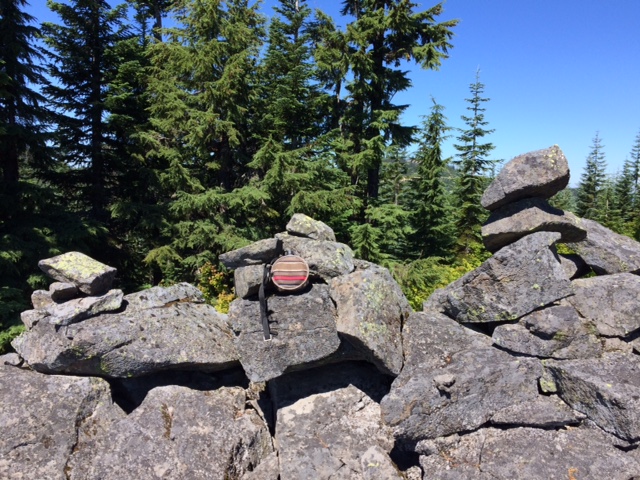
In a roundabout way, there is importance in the Glen Thomas hoaxed sightings. Like any hoaxer, Thomas conforms to certain patterns and methodologies. Discern these and you lay threadbare the hoaxer—a must in bigfoot research, whether for the academic or the layman or someone who just approaches the subject with an open mind and wants to balance out the truths, bleed out the lies, and juggle the pros and cons. In the case of Thomas, it was matching encounter stories to uncommon locales that naturally lend themselves to the hoax and to the wonder and trust of others, which are all part and parcel of it. Multiple bigfoot encounters are almost always the mark of hoaxers. Quite simply, hoaxers hoax. They keep going back to the well. And sometimes in the mind of others they carry with them an almost preternatural ability, some skill or talent or wherewithal the rest of us lack that allows them to conjure an encounter or evidence seemingly on demand, or at least from one season to the next. But putting an undue emphasis on these multiple encounter types, whether inadvertent or not, is likely to lead to biological, anatomical, and behavioral inconsistencies. In the case of Glen Thomas, we don’t get a biologically consistent animal, a biologically consistent hominin; instead we get a hybrid chimera. From this sighting event, we have a bigfoot with the nose with the sensitivity of a wolf. From this sighting as well, we have a bigfoot with thumbs that are practically useless because they are too low on the hand, despite rocks being manipulated with ease. From another sighting, a female bigfoot has the sexual swellings of a chimpanzee. In that same event, contrary to almost all eyewitness accounts, the bigfoot eat and digest the cellulose heavy water weeds of a gut heavy herbivore. In this same account, the two bigfoot sleep in the open snow, mimicking the exact and rather unusual tucked sleeping positions of an account related by Ivan Sanderson (1961) that can ultimately be traced to Eastern folklore. Should open sleep patterns such as these be the norm, contrary to almost any animal other than the domestic varieties, the bigfoot mystery should have been over long ago, which brings us to the most glaring inconsistency in all the Glen Thomas accounts—how unaware and oblivious each bigfoot is to his nearby presence. Thomas likes to settle in and watch a bigfoot or two or three for extended periods of time, observations that defy almost all other eyewitness accounts of largely fleeting encounters, of a wary, alert, evasive, shy and retreating animal. The natural pattern of an elusive hominin, often predatory, that bigfoot adheres to is the one that is most contradicted by the Thomas encounter stories. The absurdity comes to the forefront in another Thomas’ account of pulling over to the side of road in what could only be a noisy vehicle, opening doors, getting out, then, by pure happenstance, spying a female bigfoot in the bushes chomping away on willow leaves, totally oblivious to his presence while Thomas has time enough to climb a ridge to get a better look. Naturally, as with all his accounts, Thomas had a gun with him but no camera. From his encounters, we also get steady descriptions of sasquatches with short arms and protruding abdomens that contradict the body of eyewitness testimony.
About midway through his account of the sighting of the three sasquatches hunting for rodents amidst the talus slopes, Thomas relates to John Green, “I’m not sure, now about half of it…seemed like a bad dream for a while. I just couldn’t believe what was happening. It just couldn’t be, but it is” (Green, 2006). I’m convinced there is an unconscious confession here with the allusion to the bad dream. Maybe Thomas even starts to feel a tinge of guilt. And to suddenly not be sure of half an amazing story is a convenient out for someone not ultimately familiar with bigfoot anatomy and behavior and not certain if his account can possibly hold together and withstand later scrutiny. The dream-hoax being half right might be the best Thomas can hope for as he further commits to his tall tale. Maybe some researchers and laymen can even forgive Thomas for his accounts, label him more a colorful storyteller, which is how he sounds on John Green’s tapes,[8] who thought he was somehow helping by perhaps knowing a tiny something of the truth through a lifetime experienced in prime Oregon bigfoot country.
On a small scale, Glen Thomas hoaxed his sightings and led some researchers astray, and though it may seem that I have focused my analysis on him, this is just as much, if not more so about an old prospector said to live among the “apes” in Tarzan Springs, factually noted in a nearly forgotten survey book that still exists in the archives of the U.S. Geological Survey (Beelart and Olson, 2015). In my mind’s eye, I caught sight of the old prospector a number of times along Tarzan Springs, grizzled, bearded, his skin weather beaten, clothes dusty and a bit tattered, prospecting equipment in hand, stooped over and working a promising spot before moving farther downstream, fading in and out of the heavy terrain like the more elusive hominins in his midst. Perhaps we can even attribute one or two of the cairns on that talus slope to the old prospector, who, after climbing up after a hard day’s work, took a deep breath and even longer moment to contemplate Mt. Jefferson in the distance and the apes that sometimes watched him, which he caught sight of in shadow glimpses.
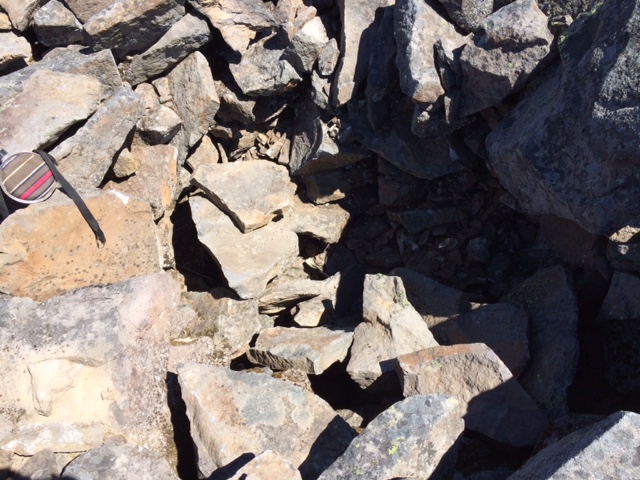
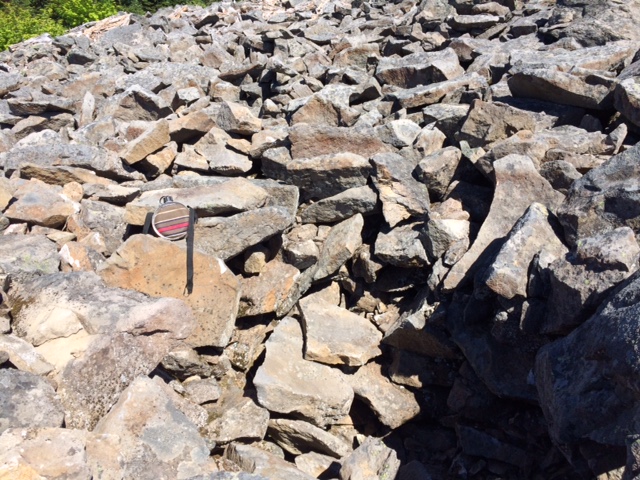
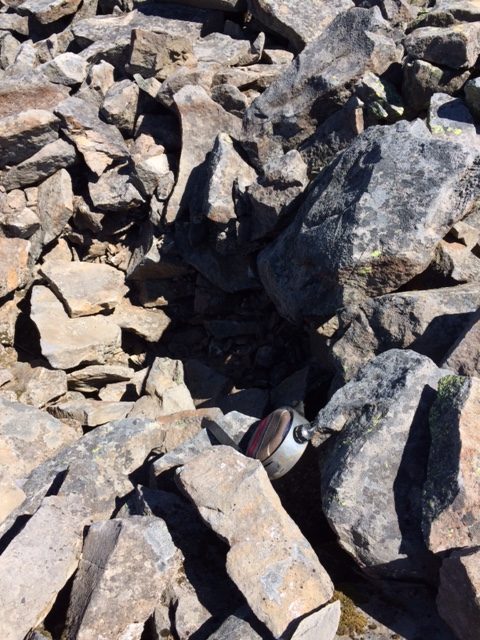
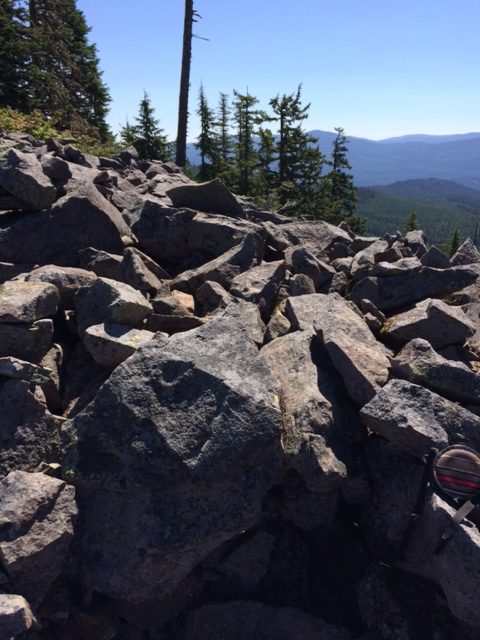
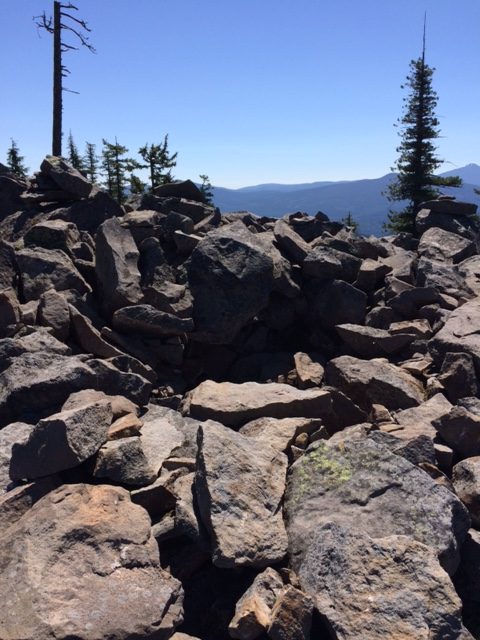
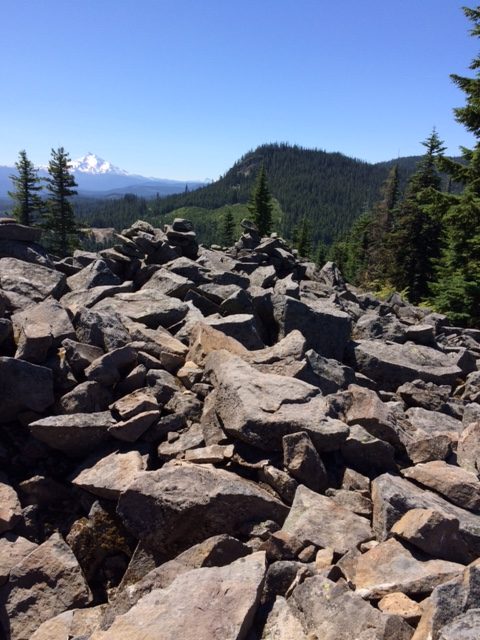
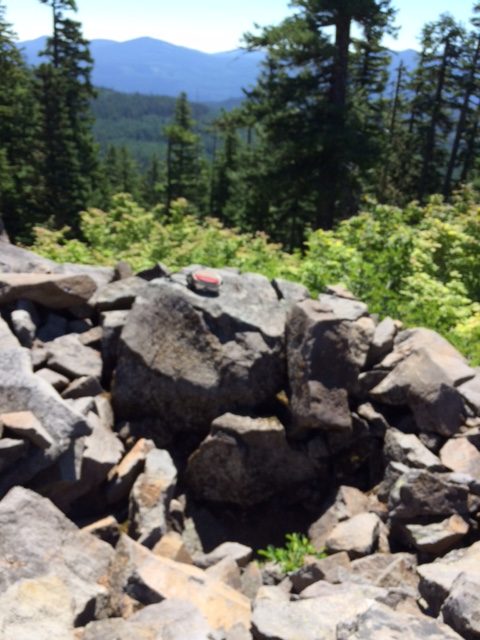
[1] Documentation such as this notation in an official government document from the archives of the 1922-23 U.S. Geological Survey contradicts authors who present the bigfoot phenomenon as devoid of historical precedent, a cultural phenomenon that arose after Jerry Crew’s footprint discovery in 1958 was reported in The Humboldt Times.
[2] See Sasquatchdatabase.com, Incident #1000305.
[3] A fire lookout at one time existed along the ridge (Burnt Granite Ridge) or nearby. There is a series of three photographs from 1934 showing the terrain and a recent burn, and one photo shows three saddled horses and a pole (with a metal box) that is held by wires tethered to the ground. Some talus is visible in the foreground and to the right. I’m not sure of the precise location of the photo or if the long rusty wire is a direct connection, but the photo does illustrate an extensive operation of some kind and that men were no strangers to the area and the Burnt Granite location. (See trailadvocate.org, Documents about the Historic Lookout Photos, specific photo retrieved from https://www.trailadvocate.org/images/LookoutPanororamaPhotos/BurntGranite/BurntGranite001.jpg)
[4] The different Native American tribes have different traditions when it comes to vision quest sites. Circular and horseshoe shaped sites made out of rock are common. Other tribes relied on a sacred locale for a vision quest site or a medicine man might choose a locale and demarcate the boundaries with certain items, etc. Elevated locations characterize most sites.
[5] The Gifford Pinchot National Forest, which is just north of the Mt. Hood National Forest and the location of the Glen Thomas site, offers this archaeological explanation for the Native American pits within its boundaries: “Archaeologists have three theories regarding the Indian Pits. One is that young Native Americans, during their spirit quest, built the pits. Seeking a spiritual vision, they would fast and sit isolated in the pits for days. Another theory is that the pits were used as hunting blinds. Until the 20th century, the Silver Star area was home to mountain sheep and goats. Both species used talus slopes to escape natural predators such as cougars or wolves. Native American hunters may have hidden in the pits waiting to ambush sheep or goats forced upslope by other hunters located in the brush and timber below. The third theory is that the pits were used as food storage areas. Similar features are commonly found throughout the Columbia River Gorge.” (See Gifford Pinchot National Forest, Trail #180E Indian Pits, https://www.fs.usda.gov/recarea/giffordpinchot/recarea/?recid=31560)
[6] I made email inquiries to both the Williamette Ranger District and the Mt. Hood Ranger District, asking for a ranger with a background in archaeology to provide feedback as to possible creation of the pits at the Glen Thomas site. I received no reply to my inquiries from the Mt. Hood Ranger District. A desk ranger from the Williamette Ranger District replied, “Hello, I don’t know anything about this so I am forwarding your inquiry to the Zone Archaeologist who is more knowledgeable of the area.” Unfortunately, I received no reply from the zone archaeologist. Personally, I can’t say that such responses, or lack thereof, were totally unexpected.
[7] Whitley, Dorn, Simon, Rechtman, & Whitley (1999), p. 234, citing Laird (1984) & Miller (1983,) state that “A related practice, both for the shaman during his vision quest and a non-shaman practicing a self-cure was the building of rock cairns.”
[8] At the time of this writing available on YouTube, The Sasquatch Archives, curated by Todd Prescott: https://www.youtube.com/watch?v=HHFtTPJGpNc
Bibliography
Beelart, J., & Olson, C. (2015). The Oregon bigfoot highway. Willamette City Press, LLC.
Documents about the Historic Lookout Photos (n.d.). In Trail Advocates. Retrieved August 9, 2017, from https://www.trailadvocate.org/images/LookoutPanororamaPhotos/BurntGranite/BurntGranite001.jpg
Green, J. (Interviewer). (1968). Glen Thomas interviewed by John Green [Online video]. Retrieved August 10, 2017, from https://www.youtube.com/watch?v=HHFtTPJGpNc
Green, J. (2015). John Green: A lifetime of sasquatch research/ Willow Creek – China Flats Museum speech. The Relict Hominoid Inquiry, 4, 10-19. Retrieved August 26, 2017, from http://www2.isu.edu/rhi/pdf/Green_Tribute_revised.pdf
Green, J. (n.d.). Sasquatch Research Engine. In Sasquatch database. Retrieved from http://www.sasquatchdatabase.com
Green, J. (2006). Sasquatch: The apes among us (2nd ed.). Surrey Canada, Hancock House.
Gulliford, A. (2000). Sacred objects and sacred places: Preserving tribal traditions. Boulder, CO: University of Colorado Press.
Sanderson, I. T. (1961). Abominable snowmen: Legend come to life; the story of sub-humans on five continents from the early ice age until today. Philadelphia, PA: Chilton.
United States Department of Agriculture Forest Service. (n.d.). Trail #180E Indian Pits. In Gifford Pinchot National Forest. Retrieved August 2, 2017, from https://www.fs.usda.gov/recarea/giffordpinchot/recarea/?recid=31560
Vision Quest (n.d.). In Native Americans Online. Retrieved August 1, 2017, from http://www.native-americans-online.com/index.html
Whitley, D. S., Dorn, R. I., Simon, J. M., Rechtman, R., & Whitley, T. K. (1999, October). Sally’s Rockshelter and the Archaeology of the Vision Quest. Cambridge Archaeological Journal, 9(2), 221-247. doi:10.1017/S0959774300015390
Wilson, T. A. (2015). Bigfoot in evolutionary perspective: The hidden life of a North American hominin. North Charleston, SC: CreateSpace Independent Publishing Platform.
Zimmerman, L. J. (2016). The sacred wisdom of the Native Americans. New York, NY: Chartwell Books.
Copyright T. A. Wilson 2017-18. All rights reserved.
